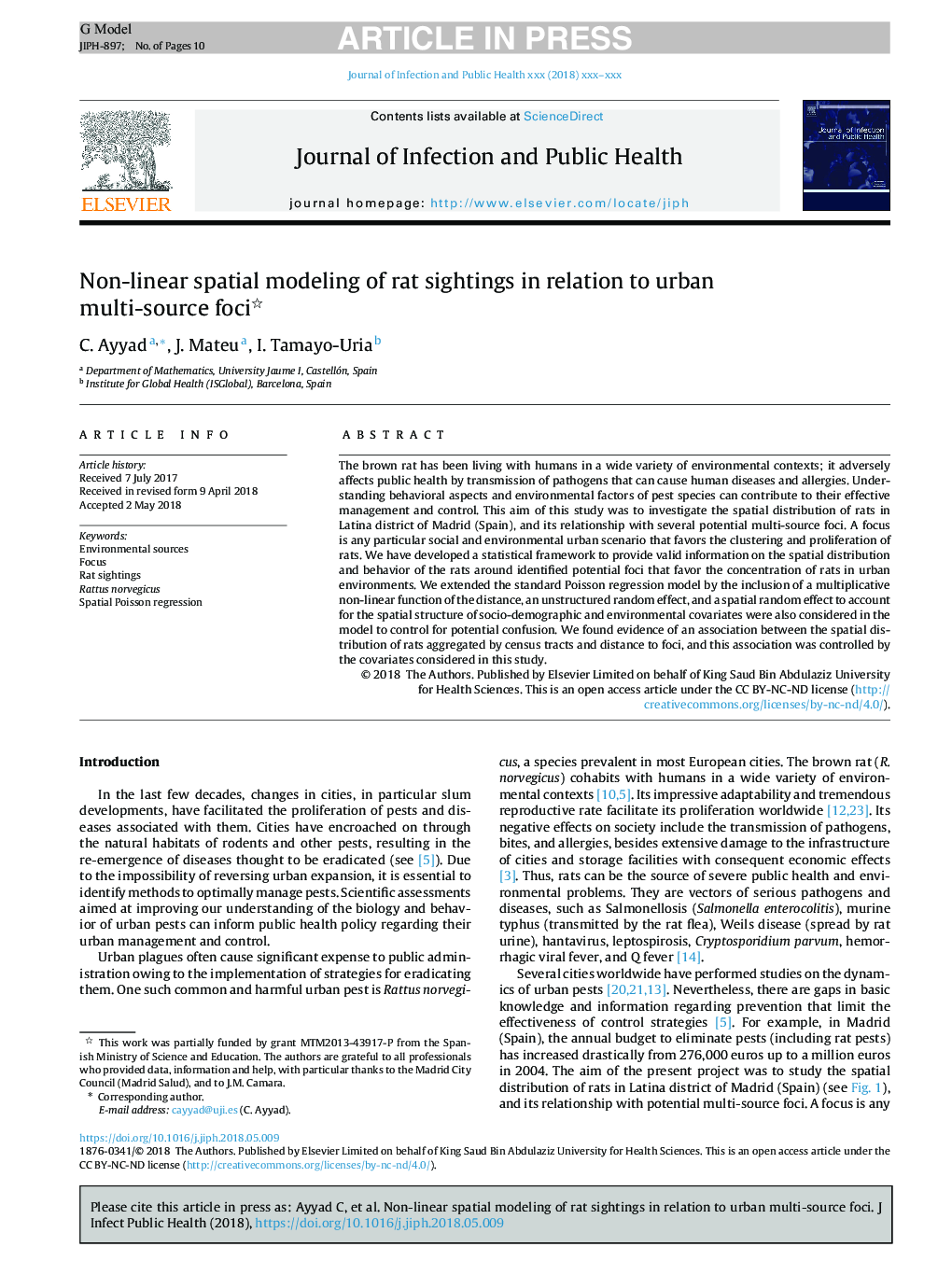| کد مقاله | کد نشریه | سال انتشار | مقاله انگلیسی | نسخه تمام متن |
|---|---|---|---|---|
| 8957999 | 1646236 | 2018 | 10 صفحه PDF | دانلود رایگان |
عنوان انگلیسی مقاله ISI
Non-linear spatial modeling of rat sightings in relation to urban multi-source foci
ترجمه فارسی عنوان
مدل سازی فضایی غیر خطی مشاهدات موش در ارتباط با کانون های چند منبع شهری
دانلود مقاله + سفارش ترجمه
دانلود مقاله ISI انگلیسی
رایگان برای ایرانیان
کلمات کلیدی
ترجمه چکیده
موش قهوه ای با انواع مختلفی از محیط زیست زندگی کرده است. آن را با انتقال بیماری هایی که می تواند باعث بیماری ها و آلرژی های انسان شود، بر سلامت عمومی تأثیر می گذارد. شناخت جنبه های رفتاری و عوامل محیطی گونه های آفات می تواند به مدیریت و کنترل موثر آنها کمک کند. هدف از این مطالعه بررسی توزیع فضایی موش صحرایی در ناحیه لاتینا مادرید (اسپانیا) و ارتباط آن با چندین کانون چندگانه بالقوه است. تمرکز هر سناریوی شهری اجتماعی و محیطی خاص است که به خوشه بندی و تکثیر موشها کمک می کند. ما یک چارچوب آماری را برای ارائه اطلاعات معتبر در مورد توزیع و رفتار فضایی موشها در اطراف فاکتورهای احتمالی شناسایی شده که به غلظت موش های صحرایی در محیط های شهری کمک می کند، ارائه کردیم. ما مدل رگرسیون پواسون استاندارد را با استفاده از تابع غیرخطی چندگانه از راه دور، اثر تصادفی بدون ساختار گسترش دادیم و اثر تصادفی فضایی برای حساب کردن ساختار فضایی متغیرهای اجتماعی-دموگرافیک و محیطی در مدل نیز مورد توجه قرار گرفت برای کنترل سردرگمی احتمالی. ما شواهدی مبنی بر ارتباط بین توزیع فضایی موشهای جمعآوری شده توسط دستگاههای سرشماری و فاصله تا فوندا پیدا کردیم و این ارتباط توسط متغیرهای مورد نظر در این مطالعه تحت کنترل قرار گرفت.
موضوعات مرتبط
علوم پزشکی و سلامت
پزشکی و دندانپزشکی
بیماری های عفونی
چکیده انگلیسی
The brown rat has been living with humans in a wide variety of environmental contexts; it adversely affects public health by transmission of pathogens that can cause human diseases and allergies. Understanding behavioral aspects and environmental factors of pest species can contribute to their effective management and control. This aim of this study was to investigate the spatial distribution of rats in Latina district of Madrid (Spain), and its relationship with several potential multi-source foci. A focus is any particular social and environmental urban scenario that favors the clustering and proliferation of rats. We have developed a statistical framework to provide valid information on the spatial distribution and behavior of the rats around identified potential foci that favor the concentration of rats in urban environments. We extended the standard Poisson regression model by the inclusion of a multiplicative non-linear function of the distance, an unstructured random effect, and a spatial random effect to account for the spatial structure of socio-demographic and environmental covariates were also considered in the model to control for potential confusion. We found evidence of an association between the spatial distribution of rats aggregated by census tracts and distance to foci, and this association was controlled by the covariates considered in this study.
ناشر
Database: Elsevier - ScienceDirect (ساینس دایرکت)
Journal: Journal of Infection and Public Health - Volume 11, Issue 5, SeptemberâOctober 2018, Pages 667-676
Journal: Journal of Infection and Public Health - Volume 11, Issue 5, SeptemberâOctober 2018, Pages 667-676
نویسندگان
Carlos Ayyad, Jorge Mateu, Ibon Tamayo-Uria,
